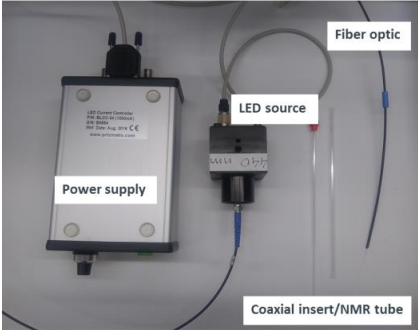Goldstone Scientific Blog
Popular Configurations - Fiber Coupled LED for In Situ NMR Spectroscopy - Updated March 2025
Posted by Nathaniel Sperka on 2nd Jan 2019
NOTE: Scroll down to see the March 2025 update section with new options
One application that is gaining popularity is a fiber coupled LED for NMR Spectroscopy. The set up that most people ask for is a Mic-LED and controller with fiber coupler adapter and a long plastic fiber optic.
This set up can be seen in the “Supporting Info” section of these two papers:
- “Discovery of a Photoinduced Dark Catalytic Cycle Using in Situ LED-NMR Spectroscopy”. September 2018
- “Facile Quantum Yield Determination via NMR Actinometry” March 2018
The last few centimeters of the optical fiber is scraped or sanded to let light leak out the side. The fiberoptic is sheaved inside of a clear plastic sheath which inserted into a larger tube with the compounds being analyzed. The fiber optic assembly is inserted into the magnet bore.
The advantage of this set up is that LEDs with different wavelengths can be used with the same controller and fiber adapter. Additional LED heads cost just $752.
Other configuration with higher power or lower cost can be considered, but most customers prefer to duplicate the configuration used in the published paper.
You can see this popular configuration here.

Update: Expanding Our Fiber-Coupled LED Options for In-Situ NMR Spectroscopy
This is an update to our first blog post “Popular Configurations - Fiber Coupled LED for In Situ NMR Spectroscopy”
When I first learned about using LEDs for NMR spectroscopy, I thought the light was used for the spectroscopy itself. Ken Conover at Princeton’s NMR Facility educated me that in fact the LEDs are not used for the spectroscopy, but rather as a photocatalytic light source.
This fact “enlightened” me to understand that the power level is important so that reactions happen faster. This was back in 2019.
A Better Choice
With this in mind, we started offering our customers fiber coupled LEDs of Prizmatix FC-LED Series instead of the original modular Mic-LED model used in the original methods paper. (pictured above)
The FC-LED series was a significant upgrade, featuring better coupling efficiency, higher power output, and lower cost. The downside was that LEDs could not be added. We solved that by introducing a hybrid setups, leaving one channel open for our modular Mic-LEDs giving researchers flexibility to adapt to various experimental needs.
This series is ideal for labs requiring multiple wavelengths, with options like a five channel LED system where each LED is independently controllable via TTL, analog, or optional USB interfaces. One channel can be left open with an electrical connector for adding new wavelengths with our Mic-LED model.
The Newest Option for Faster Reactions
Many customers wanted even higher power. The introduction of Prizmatix UHP-FB series last year filled that need. With actively cooled Ultra High Power LEDs that devices deliver the highest power currently available in a wide variety of wavelengths.
Summary: 3 Products on Goldstone for NMR Spectroscopy
- The original Mic-LED – Pros – Flexibility to add wavelengths at any time by just purchasing a modular LED head.
- FC-LED series – Pros – Lower cost, better coupling efficiency. Lack of expandability can be solved by equipping one channel with an electrical connector for Mic-LED and fiber coupler.
- UHP-FB series – Pros – absolutely highest power for faster reactions.
